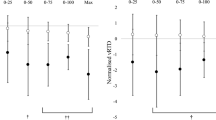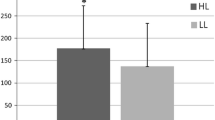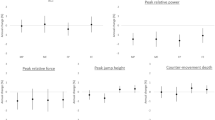Summary
Twenty male and 20 female non-professional tennis players were classified into two different age groups (n=10 per group): young active men (30.4±3.3 years), young active women (27.5±4.3 years), elderly active men (64.4±3.7 years), and elderly active women (65.3±4.5 years). These individuals were matched (n = 10 per group) according to sex, age, height and mass to sedentary individuals of the same socio-economical background: young sedentary men (29.2±3.4 years), young sedentary women (25.6±4.4 years), elderly sedentary men (65.2 ± 3.2 years) and elderly sedentary women (65.6±4.4 years). An isokinetic dynamometer was used to measure the strength of the knee extensors and flexors (two separate occasions) and the endurance of the extensors. Vastus lateralis electromyogram (EMG) was measured concomitantly. Significant sex, age and exercise effects (P<0.001) were observed for peak torque of both muscle groups. The effect of age on extensor strength was more pronounced at high speeds where men were also able to generate larger relative torques than women.
No age or sex effects were noted for muscle endurance. However, muscles of active individuals demonstrated a greater resistance to fatigue than those of sedentary individuals. In conclusion, men were found to be stronger than women, age was associated with a decrease in muscle strength, but not of muscle endurance, and tennis players were stronger and had muscles that were more resistant to fatigue than their sedentary pairs in both age groups. Although the results of this study cannot be generalized to other types of sports activities, they do give credence to the health benefits of moderate exercise in the maintenance of muscle function with age.
Similar content being viewed by others
References
Allen TH, Peng MT, Chen KP, Humng C, Fang HS (1956) Prediction of total adiposity from skinfolds and the curvilinear relationship between external and internal adiposity. Metabolism 5:346–352
Allen TH, Anderson EC, Langham WH (1960) Total body potassium and gross body composition in relation to age. J Gerontol 15:348–357
Aniansson A, Grimby G, Hedberg M, Rundgren A, Sperling L (1978) Muscle function in old age. Scand J Rehabil Med [Suppl] 6:43–49
Aniansson A, Grimby G, Rundgren A (1980) Isometric and isokinetic quadriceps muscle strength in 70 years old men and women. Scand J Rehabil Med 12:161–168
Aniansson A, Sperling L, Rundgren L, Lehnberg E (1983) Muscle function in 75 years old men and women, a longitudinal study. Scand J Rehabil Med [Suppl] 9:92–102
Aniansson A, Ljungberg P, Rundgren A, Wetterqvist H (1984a) Effect of a training programme for pensioners on condition and muscular strength. Arch Gerontol Geriatr 3:229–241
Aniansson A, Zetterberg C, Hedberg M, Henriksson KG (1984b) Impaired muscle function with aging: a background factor in the incidence of fractures of the proximal end of the femur. Clin Orthop 191:193–200
Aniansson A, Hedberg M, Henning GB, Grimby G (1986) Muscle morphology, enzymatic activity and muscle strength in elderly men: a follow-up study. Muscle Nerve 9:585–591
Belanger AT, McComas AJ (1981) Extent of motor unit activation during effort. J Appl Physiol 51:1131–1135
Bigland-Ritchie B (1981) EMG and fatigue of voluntary and simulated contractions. In: Ciba foundation symposium 82 (eds) Human muscle fatigue: physiological mechanisms. Pitman Medical, London, pp 130–156
Brooks SV, Faulkner JA (1988) Contractile properties of skeletal muscles from young, adult and aged mile. J Physiol 404:71–82
Burke RE (1980) Motor units: anatomy, physiology and functional organisation. In: Brooks VB Handbook of physiology, vol 12. The nervous system. Oxford Univ. Press, New York, pp 345–422
Davies CTM, Thomas DO, White MJ (1986) Mechanical properties of young and elderly human muscle. Acta Med Scand [Suppl] 711:219–226
Essen-Gustavsson B, Borges O (1986) Histochemical and metabolic characteristics of human muscle in relation to age. Acta Physiol Scand 126:107–114
Farmer ME, Locke BZ, Moscicki EK, Dannenberg AL, Larson DB, Radloff LS (1988) Physical activity and depressive symptoms: the Nhanes I epidemiologic follow-up study. Am J Epidemiol 128:1340–1351
Froese EA, Houston ME (1985) Torque-velocity characteristics and muscle fiber type in human vastus lateralis. J Appl Physiol 59:309–314
Fugl-Meyer AR, Gerdle B, Langstrom M (1985) Characteristics of repeated isokinetic plantar flexions in middle-aged and elderly subjects with special regard to muscular work. Acta Physiol Scand 124:213–222
Gerdle B, Johansson C, Lorentzon R (1988) Relationship between work and electromyographic activity during repeated leg muscle contractions in orienteers. Eur J Appl Physiol 58:8–12
Grimby G (1986) Physical activity and muscle training in the elderly. Acta Med Scand [Suppl] 711:233–237
Grimby G, Aniansson A, Zetterberg C, Saltin B (1984) Is there a change in relative muscle fiber composition with age? Clin Physiol 4:189–194
Ivy JL, Withhers RT, Brose G, Maxwell BD, Costill DL (1981) Isokinetic contractile properties of the quadriceps with relation to fiber type. Eur J Appl Physiol 47:247–255
Komi PV, Cavanagh PR (1977) Electromechanical delay in human skeletal muscles. Med Sci Sports 9:49
Kriska AM, Sandler RB, Cauley JA, Laporte RE, Hom DL, Pambianco G (1988) The assessment of historical physical activity and its relation to adult bone parameters. Am J Epidemiol 127:1053–1063
Laberge A, Bernard P-M, Bernard L (1988) Variations de l'inci-dence des fractures de l'extrémité supérieure du femur chez les personnes agées de la région de Québec. Can Med Assoc J 138:824–826
Larsson L, Karlsson J (1978) Isometric and dynamic endurance as a function of age and skeletal muscle characteristics. Acta Physiol Scand 104:129–136
Larsson L, Grimby G, Karlsson J (1979) Muscle strength and speed of movement in relation to age and muscle morphology. J Appl Physiol 46:451–456
Lenmarken C, Bergman T, Larsson J, Larsson LE (1985) Skeletal muscle function in man: force, relaxation rate, endurance and contraction time — dependance on sex and age. Clin Physiol 5:243–255
Lexell J, Taylor CC, Sjostrom M (1988) What is the cause of the ageing atrophy? Total number, size and proportion of different fiber types studied in whole vastus lateralis muscle from 15- to 83-year-old men. J Neurol Sci 84:275–294
MacKinnon JLL (1988) Osteoporosis, a review. Phys Ther 68:1533–1540
MacLennan WJ, Hall MRP, Timothy JI, Robinson M (1980) Is muscle weakness in old age due to muscle wasting? Age Ageing 9:188–192
McDonagh MJN, White MJ, Davies CTM (1984) Different effects of ageing on the mechanical properties of human arm and leg muscles. Gerontology 30:49–54
Morgan WP, Goldston SE (eds) (1987) Exercise and mental health. Hemisphere, Washington DC
Moritani T, DeVries HA (1980) Potential for gross muscle hypertrophy in older men. J Gerontol 35:672–682
Murray MP, Duthie EH, Gambert SR, Sepic SB, Mollinger LA (1985) Age-related differences in knee muscle strength in normal women. J Gerontol 40:275–280
Paffenbarger RS Jr, Hyde RT, Wing AL (1986) Physical activity, all cause mortality and longevity of college alumni. N Engl J Med 314:605–613
Pearson MB, Bassey EJ, Bendall MJ (1985) Muscle strength and anthropometric indices in elderly men and women. Age Ageing 14:49–54
Petrofsky JS (1978) Control of the recruitment and firing frequencies of motor units in electrically stimulated muscles in the cat. Med Biol Eng Comput 16:302–308
Pfeiffer E (1976) Multidimensional functional assessment: the oars methodology. A manual. Duke university center for the study of aging. Durham, N.C., pp 92–93
Rikli R, Busch S (1986) Motor performance of women as a function of age and physical activity level. J Gerontol 41:645–649
Rothstein JM, Delitto A, Sinacore DR, Rose SJ (1983) Electro myographic, peak torque and power relationship during isokinetic movement. Phys Ther 63:926–933
Smith DO, Rosenheimer JL (1982) Physiological and structural changes of the neuromuscular junction during aging. In: Biacobini E, Giacobini G, Filogamo G, Vernadakis A (eds) The aging brain: cellular and molecular mechanisms of aging in the nervous system. Raven Press, New York, pp 123–137
Spirduso WW (1980) Physical fitness, aging, and psychomotor speed: a review. J Gerontol 35:850–865
Tesch P (1980) Muscle fatigue in man with special reference to lactate during short term intense exercise. Acta Physiol Scand [Suppl] 480:3–40
Thorstensson A (1976) Muscle strength, fiber types and enzymes activities in man. Acta Physiol Scand 98:318–322
Thorstensson A, Karlsson J (1976) Fatigability and fiber composition of human skeletal muscle. Acta Physiol Scand 98:318–322
Vandervoort AA, McComas AJ (1986) Contractile changes in opposing muscles of the human ankle joint with aging. J Appl Physiol 61:361–367
Author information
Authors and Affiliations
Rights and permissions
About this article
Cite this article
Laforest, S., St-Pierre, D.M.M., Cyr, J. et al. Effects of age and regular exercise on muscle strength and endurance. Europ. J. Appl. Physiol. 60, 104–111 (1990). https://doi.org/10.1007/BF00846029
Accepted:
Issue Date:
DOI: https://doi.org/10.1007/BF00846029




